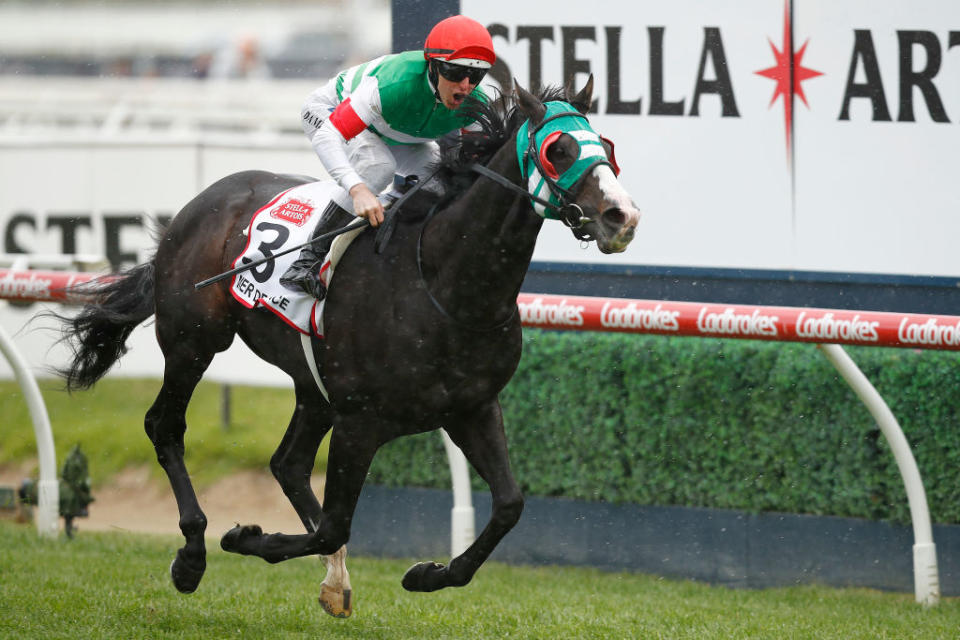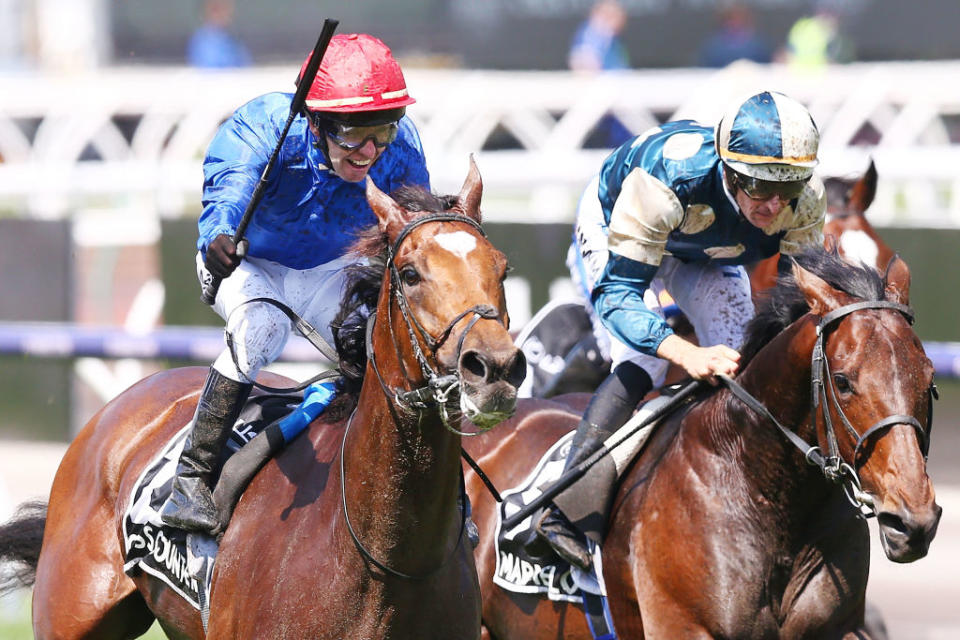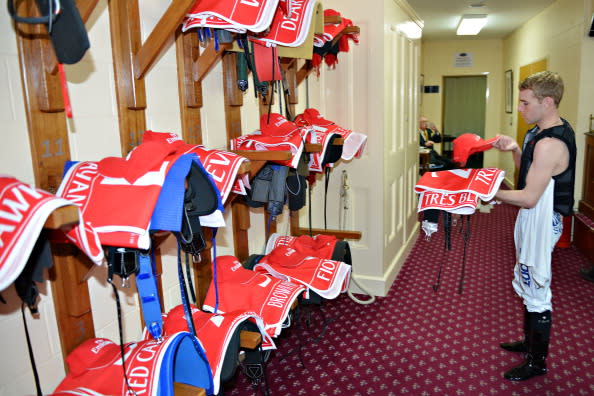Melbourne Cup: The A to Z of picking the 2019 winner
The 159th running of the Melbourne Cup will again stop the nation on Tuesday with all the colour, controversy and intrigue of one of the world’s greatest horse races. Horses, trainers and jockeys come from all around the world for the $8m race, and it is a tough job picking the winner.
Here’s our A to Z guide to give you a leg up before you place your bet on the Cup.
MELBOURNE CUP FIELD, FORM AND TIPS
A
A is for Aussie-bred horses. There are only four that can be considered locals. Steel Prince, Vow and Declare, Youngstar and Surprise Baby (he was born in NZ but has done all his racing here). The rest are trained overseas and brought here for the race, or bought overseas and handed to local trainers to prepare for a Cup campaign.
B
B is for Barriers. The barrier or gate is the number in brackets that usually sits beside the jockey’s name. It refers to the position in the starting gate the horse starts from. 1 is closest to the fence and 24 is the widest. Inside barriers (in single figures) are considered an advantage, but a wide draw won’t stop a good horse from winning. Last year’s winner Cross Counter jumped from barrier 19. Barrier 18 is the only gate a Melbourne Cup winner is yet to jump from, while barrier 11 has been the most successful.

C
C is for crowds. A crowd of over 100,000 is likely to be at Flemington racecourse on Tuesday. It will be loud and crazy, and an atmosphere that not all horses will be comfortable with. You will see some horses parading before the race with some radical red headgear, that may include visors and ear muffs to keep the horse calm. Some of the internationals that have not raced at big meetings may be unsettled.
D
D is for donkey. The colloquial term for picking a horse with bugger-all chance, or what you may refer to your selection after it finishes near the tail of the field. But the quality of this year’s field is high and most horses are in the race with a winning chance.
Getting into the pointy end now. But let's be honest, this is the only way I'm getting a winner in the next 5 days.. #springcarnival #derbyday #melbournecup pic.twitter.com/n6CyzfVlrr
— Christopher Bawden 🇦🇺 (@bawdz) (@bawdzisnaughty) October 31, 2019
E
E is for the early money. The Irish-bred Constantinople, now with the Australian trainer David Hayes, was favourite for the race before Saturday night’s barrier draw. The next horse in the betting was the Japanese-trained Mer De Glace who won the Caulfield Cup. A key lead-up to the Melbourne Cup.

F
F is for favourites. The horse the market determines has the best chance of winning will have the lowest-priced odds and start favourite. Does the favourite usually win? No. The last outright favourite to win the Cup was Fiorente in 2013. Over the last 20 years only three outright favourites have won the Cup. The last three winners were well-fancied, with starting prices ranging from $9 to $15, but in 2015 Michelle Payne won on 100-1 shot Prince of Penzance.
G
G is for girls. Michelle Payne becoming the first female jockey to win the Cup in 2015, is the subject for the hit film, Ride Like a Girl. But it looks like there will be no female riders in the 2019 Cup, despite the likes of Jamie Kah and Linda Meech having great seasons riding in Melbourne. Look out for those women in other races at Flemington on the day. And it appears there will be only one female trainer in the race – Natalie Young, who trains Mirage Dancer in partnership in Victoria with Trent Busuttin.
H
H is for handicap. The Melbourne Cup is the world’s richest handicap, meaning the best rated horses are given a weight penalty, so that all runners ideally have an equal chance of winning. It is not necessarily the best horse that wins the Melbourne Cup, but often a good horse that gets into the race without too much weight. In recent years it has been horses with lower weights – those that have escaped the handicapper that have come up trumps in the race.

I
I is for Internationals. The modern race is dominated by international horses, mainly from Europe. The past two winners had never raced in Australia before starting in the Cup. With almost $8 million in prize money on offer the world’s biggest racing operations target the Cup. They are provided with a top class quarantined training facility at Weribee, and are fit and ready to go by Cup Day. Stories of the battling Aussie trainer getting a horse into the Cup are rare – but Surprise Baby from country Victoria has made it this year.
J
J is for Jockey. Damien Oliver, Kerrin McEvoy and Glenn Boss have both won the Melbourne Cup three times. Bossy, who won his trio on the great mare Makybe Diva, is set to miss the Cup due to suspension. He was going to ride Constantinople but has been replaced by Hong Kong star Joao Moreira. Oliver rides British import Mustajeer, McEvoy is on Finche. Another jockey on a hot-trot is Damien Lane. He won the Cox Plate on Japan’s Lyx Gracieur. In the Cup he ride’s Japanese horse Mer de Glace who he rode to an impressive win in the Caulfield Cup two weeks back. Among the international jockeys is the world-renowned Frankie Dettori who chases his first Cup win on Master of Reality.
K
K is for Kerrin McEvoy. The hot Cups jockey who has won two of the past three Melbourne Cups. Last year the Sydney-based McEvoy was first past the post on Cross Counter. Two years earlier McEvoy won the Cup on Amaldin. His first Cup win was back in 2000 on Brew. Cross Counter is back from the UK hoping to win back-to-back Cups, but McEvoy has instead opted to ride Finche for top Sydney trainer Chris Waller.

L
L is for leader. If you pick a horse that likes to lead the field, then it may look like the winner a long way from home. But, don’t go the early crow – it’s a long race and not many horses can sustain that pressure for 3200m. It’s more than likely the winner will emerge from midfield to grab the lead in the shadows of the post.
M
M is for mud runner. If the track is rain-affected look for horses that have won on slow going. Those kind of conditions should particularly favour many of the Europeans who will appreciate “the sting out of the ground”. Rain fell at Flemington on the weekend but the track may dry out by Tuesday.
N
N is for name. Plenty of bets will be placed on the name alone. The amorous might opt for Surprise Baby, the cricketers might plunge on [Aaron] Finche, while TV and movie fans might be swayed a number of ways. Raymond Tusk is named after the House of Cards character, Master of Reality covers all shows in that genre, Twilight fans will see see a name jump out for them, while lovers of Italian cinema might opt for Il Paradiso.
O
O is for the O’Brien. Three different trainers all with the same surname – all with great hopes in the Cup. Melbourne trainer Danny O’Brien has a good chance of winning his first Cup with Vow and Declare. Ireland’s Aidan O’Brien is regarded as one of the best trainers in the world, but is yet to win the Cup. He’ll have Il Paradiso, Magic Wand and Hunting Horn. His son Joseph, who the race two years ago, has Downdraft, Latrobe, Master of Reality and Twilight Payment.

P
P is for prize money. The Melbourne Cup is now worth $8 million, making it the fifth richest horse race in the world and the richest handicap race. The winner will receive $4.4m and $250,000 worth of trophies. Prize money is paid all the way down to 12th place. The rich offering is why horses are coming from all over the world to compete making it so difficult to pick the winner.
Q
Q is for Quinella. If you are not challenged enough by picking the winner, the Quinella is a betting type where you pick the first two horses to finish the race. European bred horses have run one-two for the past three years, so that might be a good formula to follow.
R
R is for race start time. The Melbourne Cup will start at 3pm on Tuesday and will be televised live on Channel 10. Get your bets on early and enjoy the race. The 10-race program at Flemington begins at 10.50am and the last race is at 5.15pm.

S
S is for saddle cloth numbers. Horse numbers 4 and 12 have been the most successful since the Melbourne Cup was first raced in 1875. Both of those saddlecloth numbers have produced 11 winners each. High numbers, where horses carry lower weights have been winning in recent years.
T
T is for the two miles, or thirty two hundred metres of the race. It’s a bloody long way and not all horses will run out the distance strongly, so look for a horse that has performed well at a distance of 2800m or more.
U
U is for ugly. This may describe the scenes late on Cup day after a punter has done his dough, or been on the booze all day. Glamour gives way to the reality of trying to walk in heels after 10 champagnes while still keeping the fascinator sitting pretty. Tip of the day: Don’t bet over your head.

V
V is for vet check. All horses headed for the Melbourne Cup undergo veterinary checks by Racing Victoria before they are accepted into the final field. The 3200m race is a gruelling, long-distance race and the race club wants to minimise the risk of a horse breaking down during the run as has happened a couple of times in recent years. With uncertainty over the condition of horses are making long flights from Europe, RV has also been carrying out mandatory CT scans of those horses. This led to the controversial scratching on Wednesday before the Cup of 2018 runner-up Marmelo.
W
W is for weight. The Melbourne Cup is a handicap. The race handicapper will give the best credentialed runners the biggest weight penalty. The less experienced runners will get the lowest weights. The handicapper’s aim is to create weight penalties that will give all horses equal chance. In the racing game they say weight will stop a train so trainers will often try and get horses into the cup that don’t have too big a weight.
X
X is for X factor. The horse with the untapped talent that might blow the others away. There is no Winx in this field. She retired in April with over $26 million in prize money, having never been stretched out to the 3200m of the Cup. But there is Surprise Baby, a bargain horse bought for $5500 that won the Adelaide Cup (3200m) at just its sixth start, while Irish horse Il Paradiso is racing in just its seventh start on Tuesday.

Y
Y is for You Beauty! The cry comes when against all odds you pick the winner of the Melbourne Cup. Others around might manage a wry smile as they try and hide the disappointment of not coming up with the winner. While you add some colour to an almost empty wallet, spare a thought for the winning jockey and trainer who will probably collect at least $200,000 each as the winning owners divvy up the $4,400,000 first prize.
Z
Z is for zero. That’s the chance of winning if you don’t have a bet, but you won’t lose anything either. Enjoy the day, let your hair down and soak up the atmosphere of the race that stops the nation.

